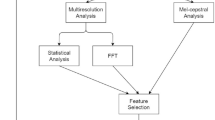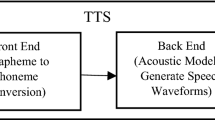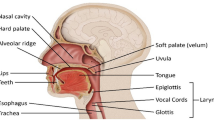Abstract
In this paper, the explicit and implicit modelling of the subsegmental excitation information are experimentally compared. For explicit modelling, the static and dynamic values of the standard Liljencrants–Fant (LF) parameters that model the glottal flow derivative (GFD) are used. A simplified approximation method is proposed to compute these LF parameters by locating the glottal closing and opening instants. The proposed approach significantly reduces the computation needed to implement the LF model. For implicit modelling, linear prediction (LP) residual samples considered in blocks of 5 ms with shift of 2.5 ms are used. Different speaker recognition studies are performed using NIST-99 and NIST-03 databases. In case of speaker identification, the implicit modelling provides significantly better performance compared to explicit modelling. Alternatively, the explicit modelling seem to be providing better performance in case of speaker verification. This indicates that explicit modelling seem to have relatively less intra and inter-speaker variability. The implicit modelling on the other hand, has more intra and inter-speaker variability. What is desirable is less intra and more inter-speaker variability. Therefore, for speaker verification task explicit modelling may be used and for speaker identification task implicit modelling may be used. Further, for both speaker identification and verification tasks the explicit modelling provides relatively more complimentary information to the state-of-the-art vocal tract features. The contribution of the explicit features is relatively more robust against noise. We suggest that the explicit approach can be used to model the subsegmental excitation information for speaker recognition.











Similar content being viewed by others
References
Ananthapadmanabha T V and Fant G 1982 Calculation of true glottal flow and its components. Speech Commun. 1: 167–184
Ananthapadmanabha T V and Yegnanarayana B 1979 Epoch extraction from linear prediction residual for identification of closed glottis interval. IEEE Trans. on Acoust., Speech and Signal Process. ASSP-27: 309–319
Atal B S 1972 Automatic speaker recognition based on pitch contours. J. Acoust. Soc. Amer. 52(6): 1687–1697
Atal B S 1976 Automatic recognition of speakers from their voices. Proc. IEEE 64(4): 460–475
Bimbot F, Bonastre J-F, Fredouille C et al 2004 A tutorial on text-independent speaker verification. EURASIP Journal on Applied Signal Processing 4: 430–451
Campbell J P Jr 1997 Speaker recognition: A tutorial. Proc. IEEE 85(9): 1437–1462
Carlson R, Fant G, Gobl C, Granstrom B, Karlsson I and Lin Q-G 1989 Voice source rules for text-to-speech synthesis. In: Int. conf. on Acoust. Speech and Signal Process. (ICASSP) vol. 1, Glasgow, Scotland, 223–226
Cohen L 1995 Time-frequency analysis: theory and application, ser. Signal Processing Series. Englewood Cliffs: Prentice Hall
Davis S B and Mermelstein P (1980) Comparison of parametric representations for monosyllabic word recognition in continuously spoken sentences. IEEE Trans. Acoust. Speech and Signal Process. 28(28): 357–366
Deller J R Jr, Hansen J H L and Proakis J G 1993 Discrete-time processing of speech signal, 2nd ed. New York: IEEE Press
Duda R O and Hart P E 2001 Pattern Classification, 2nd ed. Willy
Ezzaidi H and Rouat J 2004 Pitch and MFCC dependent GMM models for speaker identification systems. In: IEEE int. conf. on Electrical and Computer Engg., vol. 1
Furui S 1981a Cepstral analysis technique for automatic speaker verification. IEEE Trans. Acoust. Speech, and Signal Process. 29(2): 254–272
Furui S 1981b Comparison of speaker recognition methods using static features and dynamic features. IEEE Trans. Acoust., Speech and Signal Process. ASSP-29(3): 342–350
Furui S 2005 Fifty years progress in speech and speaker recognition research. Proc. SPECOM. Patras, Greece, 1–9
Haeb-Umbach R 1999 Investigation on inter-speaker variability in the feature space. In: Int. conf. on Acoust. Speech and Signal Process. (ICASSP), Phoenix, AZ, 397–400
Hall J J and Srihari S N 1994 Decision combination in multiple classifier systems. IEEE Trans. Patt. Anal. and Mach. Intell. 16: 66–75
Hari Krishnan P, Padmanabhan R and Murthy H A 2006 Robust voice activity detection using group delay functions. In: Proc. IEEE International Conference on Industrial Technology, 2603–2607
Hayakawa S, Takeda K and Itakura F 1997 Speaker identification using harmonic structure of lp-residual spectrum. Biometric personal Aunthentification, Lecture notes, vol. 1206. Springer, Berlin, 253–260
Huang W, Chao J and Zhang Y 2008 Combination of pitch and MFCC GMM supervectors for speaker verification. In: IEEE int. conf. on Audio, Language and Image Process. (ICALIP), 1335–1339
Iseli M R and Alwan A 2000 Inter- and intra-speaker variability of glottal flow derivative. In: Int. conf. on Spoken Language Processing (ICSLP, 2000), Beijing, Chaina
Karlsson I 1988 Glottal waveform parameters for different speaker types. STL-QPSR, 29(2–3): 61–67
Kittler J, Hatef M, Duin R P W and Matas J 1998 On combining classifiers. IEEE Trans. Patteren Analysis and Machine Intelligence 20(3): 226–239
Kominek J and Black A 2004 CMU-Arctic speech database. In: 5th ISCA Speech Synthesis Workshop. Pittsburg, PA, 223–224
Makhoul J 1975 Linear prediction: A tutorial review. Proc. IEEE 63(4): 561–580
Martin A, Doddington G, Kamm T, Ordowski M and Przybocki M 1997 The DET curve in assessment of detection task performance. In: Proc. Eur. Conf. on Speech Communication Technology, vol. 4. Rhodes, Greece, 1895–1898
Mary L and Yegnanarayana B (2008) Extraction and representation of prosodic features for language and speaker recognition. Speech Commun. 50: 782–796
Murty K S R and Yegnanarayana B 2006 Combining evidence from residual phase and MFCC features for speaker recognition. IEEE Signal Process. Lett. 13(1): 52–55
Murthy K S R and Yegnanarayana B 2008 Epoch extraction from speech signal. IEEE Trans. Audio Speech and Language Process. 16(8): 1602–1613
Murthy K S R and Yegnanarayana B 2009 Characterization of glottal activity from speech signal. IEEE Signal Process. Lett. 16(6): 469–472
Murty K S R, Prasanna S R M and Yegnanarayana B 2004 Speaker specific information from residual phase. In: Int. Conf. on Signal Proces. and Comm. (SPCOM)
Naylor P A, Kounoudes A, Gudnason J and Brookes M 2007 Estimation of glottal closure instants in voiced speech using the dypsa algorithm. IEEE Trans. Audio Speech and Language Process. 15(1):34–43
Padmanabhan R and Murthy H A 2010 Acoustic feature diversity and speaker verification. In: INTERSPEECH 2010, Makuhari, Chiba, Japan, 2010–2013
Pati D and Prasanna S R M 2008 Non-parametric vector quantization of excitation source information for speaker recognition. In: Proc. IEEE TENCON, 1–4
Pati D and Prasanna S R M 2010 Speaker information from subband energies of linear prediction residual. In: Proc. NCC 2010, 1–4
Pati D and Prasanna S R M 2011 Subsegmental, segmental and suprasegmental processing of linear prediction residual for speaker information. Int. J. of Speech Technology, Springer 14(1): 49–63
Pati D and Prasanna S R M 2013 Processing of linear prediction residual in spectral and cepstral domains for speaker information. Proceedings in Communicated to SADHNA Academy Proceedings in Engineering Sciences, Springer
Plumpe M D, Quatieri T F and Reynolds D A 1999 Modelling of glottal flow derivative waveform with application to speaker identification. IEEE Trans. Speech and Audio Process. 7(5): 569–586
Prasanna S R M, Gupta C S and Yegnanarayana B (2006) Extraction of speaker-specific excitation information from linear prediction residual of speech. Speech Commun. 48: 1243–1261
Pruzansky S and Mathews M V 1964 Talker-recognition procedure based on analysis of variance. J. Acoust. Soc. Amer. 36(11): 2041–2047
Przybocky M and Martin A 2000 The NIST-1999 speaker recognition evaluation- An overview. Digital Signal Processing 10: 1–18
Przybocky M and Martin A 2003 Nist speaker recognition evaluation plan. In: Proc. NIST Speaker Recognition Workshop, College Park, MD
Qi Y and Bi N 1994 A simplified approximation of the four-parameter LF model of voice source. J. Acoustic. Soc. Amer. 96(2): 1182–1185
Reynolds D A 1994 Experimental evaluation of features for robust speaker identification. IEEE Trans. Speech Audio Process. 2(4): 639–643
Reynolds D A and Rose R C 1995 Robust text-independent speaker identification using gaussian mixture speaker models. IEEE Trans. Speech and Audio Process. 3(1): 4–17
Strik H 1998 Automatic parameterization of differentiated glottal flow: Comparing methods by means of synthetic flow pulses. J. Acoust. Soc. Amer. 103(5): 2659–2669
Thevenaz P and Hugli H 1995 Usefulness of the LPC-residue in text-independent speaker verification. Speech Commun. 17: 145–157
Veldhuish R 1998 A computationally efficient alternative for the Liljencrants-Fant model and its perceptual evaluation. J. Acoust. Soc. Amer. 103(1): 566–571
Wang N, Ching P C and Lee T 2009 Exploration of vocal excitation modulation features for speaker recognition. In: Proc. INTERSPEECH-09, Brighton UK, 892–895
Wolf J J 1972 Efficient acoustic parameters for speaker recognition. J. Acoust. Soc. Amer. 51(2): 2044–2055
Yegnanarayana B and Veldhuis R N J 1998 Extraction of vocal-tract system characterstics from speech signals. IEEE Trans. Speech Audio Proc. 6(4): 313–327
Yegnenarayana B and Murthy K S R 2009 Event based instantaneous fundamental frequency estimation from speech signals. IEEE Trans. Audio, Speech and Language Process. 17(4): 614–624
Yegnanarayana B and Prasanna S R M 2010 Analysis of instantaneous F0 contours from two speakers mixed signal using zero frequency filtering. In: Int. Conf. on Acoust. Speech and Signal Process. (ICASSP), Dallas, Texas, USA, 5074–5077
Yegnanarayana B, Prasanna S R M, Zachariah J M, Gupta C S 2005 Combining evidences from source, suprasegmental and spectral features for fixed-text speaker verification study. IEEE Trans. on Speech and Audio Process. 13(4): 575–582
Yegnanarayana B, Reddy K S and Kishore S P 2001 Source and systsem feature for speaker recognition using AANN Models. Proc. IEEE Int. Conf. Acoust. Speech and Signal Process. Salt Lake City, UT, USA, 409–412
Zheng N, Lee T and Ching P C 2007 Integration of complimentary acoustic features for speaker recognition. IEEE Signal Process. Lett. 14(3): 181–184
Author information
Authors and Affiliations
Corresponding author
Rights and permissions
About this article
Cite this article
PATI, D., MAHADEVA PRASANNA, S.R. A comparative study of explicit and implicit modelling of subsegmental speaker-specific excitation source information. Sadhana 38, 591–620 (2013). https://doi.org/10.1007/s12046-013-0163-z
Received:
Accepted:
Published:
Issue Date:
DOI: https://doi.org/10.1007/s12046-013-0163-z




